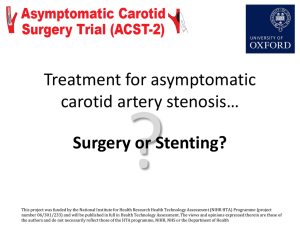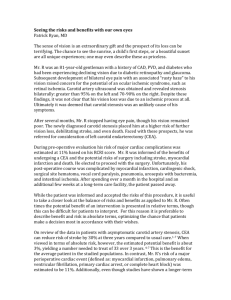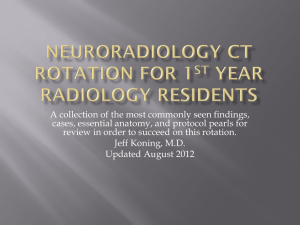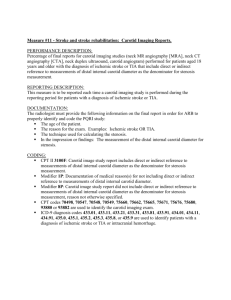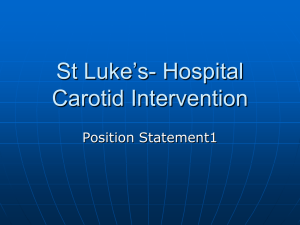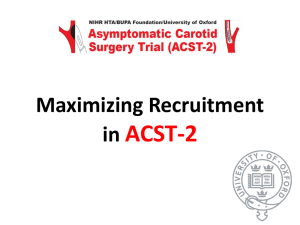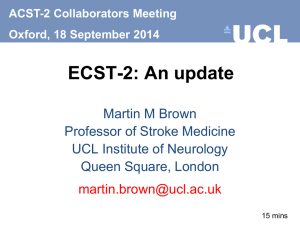1 - Georgia Neurological Society
advertisement
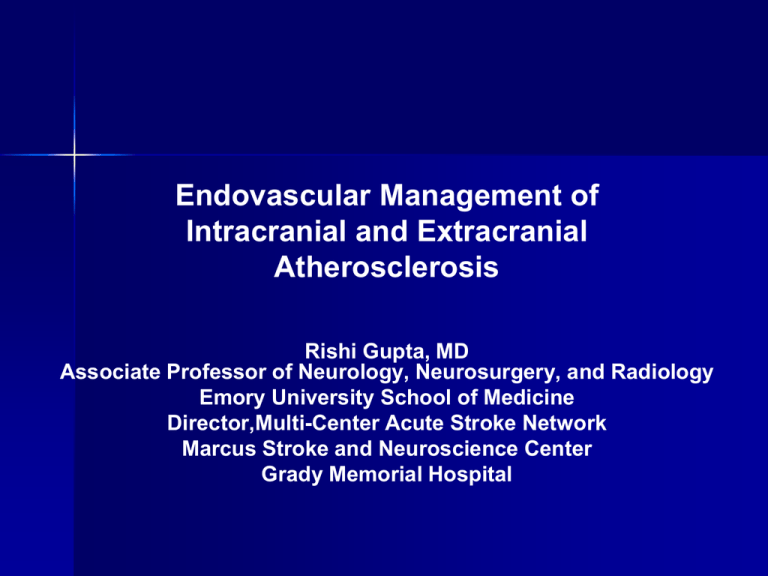
Endovascular Management of Intracranial and Extracranial Atherosclerosis Rishi Gupta, MD Associate Professor of Neurology, Neurosurgery, and Radiology Emory University School of Medicine Director,Multi-Center Acute Stroke Network Marcus Stroke and Neuroscience Center Grady Memorial Hospital Extracranial Carotid Artery Disease 700,000 Strokes annually in the US 1 Extracranial carotid artery disease accounts for 1015 % of Ischemic Cerebral Infarctions 2 Causes cognitive impairment 3 1Ovbiagele et al. , Stroke 2003 2 Whisnant 1995 3 Rao et al., Stroke 1999 Natural History of Carotid Disease Strongest predictors of future events 1 Prior ipsilateral hemispheric symptoms Degree of stenosis Other predictors of future events Unstable plaque 2 (ulceration, intraplaque hemorrhage, intraluminal thrombus) Hemodynamic impairment 3,4,5 Coexistence of both 6 1 2 3 Rothwell, Stroke 2000, Rothwell, Cerebrovasc.6 Dis. 2001, Silvestrini JAMA 2000, 4 5 Markus, Brain 2001, Yonas, J Neurosurg 1993 , Caplan, Arch Neurol 1999 Carotid Endarterectomy for Symptomatic High Grade Carotid Stenosis (NASCET) Complications: stroke/death 5.8% 659 patients with ischemic stroke or TIA and Carotid stenosis 70%-99% Carotid Endarterectomy (n=328) Medical management (n=331) 2 years Ipsilateral stroke 9% NASCET investigators, NEJM 1991 26% P < 0.0001 NNT=8 Carotid Endarterectomy for Symptomatic Moderate Grade Carotid Stenosis (NASCET) Complications: stroke/death 6.7% 858 patients with ischemic stroke or TIA And Carotid stenosis 50%-69% Carotid Endarterectomy (n=428) Medical management (n=430) 5 years Ipsilateral stroke 15.7% Barnett et al, NEJM 1998 22.2% P = 0.045 NNT=20 Carotid Endarterectomy for Asymptomatic Moderate-Severe Carotid Stenosis (ACAS) 1662 patients with asymptomatic Carotid stenosis 60%-99% Complications: stroke/death 2.3% Carotid Endarterectomy (n=825) Medical management (n=834) 5 years Ipsilateral Stroke, Death 5.1% ACAS investigators, JAMA 1995 11% P = 0.004 NNT= 48 Asymptomatic Carotid Surgery Trial (ACST) 3120 patients with asymptomatic Carotid stenosis 60%-99% Carotid Endarterectomy Medical management 5 years Stroke, Death 6.4% ACST Investigators, Lancet 2004 11.8% P = 0.001 Asymptomatic Carotid Stenosis Interestingly, with a decade between ACAS and ACST, natural history of asymptomatic carotid stenosis did not change Rates of anti-platelet therapy use higher in ACAS and statin implementation higher compared to ACAS High Surgical Risk for CEA Risk factors – Age > 75 – Ipsilateral carotid occlusion – Carotid siphon stenosis – Intraluminal thrombus Not considered – MI within 6 months – Severe hypertension – CHF – COPD – Severity of stenosis – Contralateral carotid stenosis – Ulceration Goldstein et al. Stroke 25;1116, 1994 High Surgical Risk for CEA • 1160 CEAs at 12 hospitals - Retrospective review Risk Factors 0 # Pts 482 MI, Str, Dth 6.4% 1 197 12.2% 2 16 18.8% 3 2 50.0% 1-3 215 13.0% Goldstein et al. Stroke 25;1116, 1994 Carotid Artery Stenting/Angioplasty (CAS) First performed in the 1980’s Early clinical trials for high risk CEA patients - Clinical registries, SAPPHIRE More recently, RCT comparing to CEA in low risk patients SAPPHIRE: Study Design Randomized, multi-center trial comparing carotid stenting with protection vs. endarterectomy in high surgical risk patients Prove Non-Inferiority of Stenting with EDP vs. CEA 80% Asymptomatic carotid stenosis or 50% symptomatic carotid stenosis Non-randomized patients entered in stent registry or surgical registry Stroke, MI and Death (Composite outcome) – 30-day post- procedure Key Inclusion Criteria: > 1 Comorbidity (Systemic) Congestive heart failure (class III/IV) and/or known severe LV dysfunction (LVEF <30%) Open heart surgery needed within six weeks Recent MI (>24 hrs. and <4 weeks) Unstable angina (CCS class III/IV) Severe pulmonary disease Age greater than 80 years Randomized Study-All Patients 30 Days Events (N= 156 vs 151) 14% 12% 10% 12.6% Stenting CEA P=0.047 7.3% 8% 5.8% 5.3% 6% 3.8% 4% 2.6% 2.0% 2% 0.6% 0% Stroke MI Death Stroke/MI/D EVA 3S Randomized trial 1:1 CEA vs CAS Designed to prove non-inferiority Symptomatic patients with 60% 524 patients enrolled Stopped prematurely due to safety and futility EVA 3S - Issues Operator experience : – – – 12 carotid stents does not require 014 experience 35 supraaortic stents (of which 5 carotids) or performance of stenting under supervision by proctor who fullfills above criteria No requirement for : - dual antiplatelet therapy (15% without) - uniform stent/protection device - use of protection device (10% without) SPACE -Randomized trial -1:1 CEA vs CAS - Designed to prove non-inferiority - Symptomatic patients with 50% (NASCET) - 1200 patients enrolled -Stopped prematurely due to lack of funding SX ICA WITH LARGE ULCERATION TREATED WITH EMBOLI PREVENTION FILTER EMBOLIZED PLAQUE Filter EMBOLIZED PLAQUE PRE FILTER POST CREST Randomized controlled study of 2502 patients with conventional risk 1:1 randomization to CAS vs. CEA Included symptomatic and Asymptomatic patients Primary endpoint of any stroke, death or MI Rigorous vetting process with a lead in phase for investigators and prior experience with a pre-defined 6% complication rate in the past Peri-procedural Stroke and MI CAS vs. CEA Hazard Ratio 95% CI Stroke MI 4.1 vs. 2.3% 1.1 vs. 2.3% PValue HR = 1.79; 95% CI: 1.142.82 0.01 HR = 0.50; 95% CI: 0.260.94 0.03 Primary Endpoint ≤ 4 years (any stroke, MI, or death within peri-procedural period plus ipsilateral stroke thereafter) CAS vs. CEA 7.2 vs. 6.8% Hazard Ratio, 95% CI HR = 1.11; 95% CI: 0.811.51 P-Value 0.51 Primary outcome – 4 year 4 Pinteraction = 0.020 Hazard Ratio 3 CEA Superior 2 1 CAS Superior 0 40 50 60 70 Age (Years) 80 90 Summary of Randomized CAS Studies # Patients Tutor Allowed Stent Type Dual Antiplatelet EPD Use 30 day stroke CAVATAS 504 No Angioplasty Aspirin 0% 8% EVA 3S 527 Yes Multiple 15% not on dual antiplatelets 91% 8.8% SPACE 1200 Yes Multiple Mandated 27% 6.5% ICSS 1710 Yes Multiple Recommended 72% 6.3% CREST 2502 No Acculink Mandated Mandated 4.1% SAPPHIRE 334 No Precise Mandated Mandated 3.6% Study Summary of Carotid Treatment Carotid revascularization recommended for patients with moderate to severe stenosis: - If Sx and survival > 2 years - If ASx and survival > 5 years CEA and CAS are both options available for revascularization Multidisciplinary approach with surgery, endovascular specialist and neurologist will likely yield best clinical outcome As with ICAD, maximal medical therapy important towards reducing risk of stroke, MI long term Conclusions Medical management pre and post carotid revascularization may impact safety, durability of treatment CAS will likely have a larger role in carotid revascularization after CREST. Interest in cognitive differences between CAS and CEA, also ? if distal vs. proximal protection leads to reduced downstream emboli


